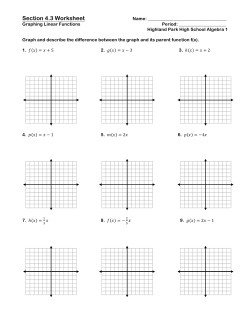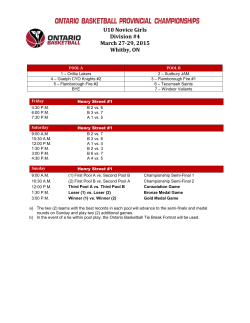
Binary Search Tree Generic
CS 3114 Data Structures and Algorithms
Minor Project 2: BST Generic
Binary Search Tree
This assignment involves implementing a standard binary search tree as a Java generic. Because this assignment will be autograded using a test harness we will provide, your implementation must conform to the public interface below, and include at
least all of the public and private members that are shown:
// The test harness will belong to the following package; the BST
// implementation will belong to it as well. In addition, the BST
// implementation will specify package access for the inner node class
// and all data members in order that the test harness may have access
// to them.
//
package Minor.P2.DS;
// BST<> provides a generic implementation of a binary search tree
//
// BST<> implementation constraints:
//
- The tree uses package access for root, and for the node type.
//
- The node type uses package access for its data members.
//
- The tree never stores two objects for which compareTo() returns 0.
//
- All tree traversals are performed recursively.
//
- Optionally, the BST<> employs a pool of deleted nodes.
//
If so, when an insertion is performed, a node from the pool is used
//
unless the pool is empty, and when a deletion is performed, the
//
(cleaned) deleted node is added to the pool, unless the pool is
//
full. The maximum size of the pool is set via the constructor.
//
// User data type (T) constraints:
//
- T implements compareTo() and equals() appropriately
//
- compareTo() and equals() are consistent; that is, compareTo()
//
returns 0 in exactly the same situations equals() returns true
//
public class BST<T extends Comparable<? super T>> {
class BinaryNode {
// Initialize a childless binary node.
// Pre:
elem is not null
// Post: (in the new node)
//
element == elem
//
left == right == null
public BinaryNode( T elem ) { . . . }
// Initialize a binary node with children.
// Pre:
elem is not null
// Post: (in the new node)
//
element == elem
//
left == lt, right == rt
public BinaryNode( T elem, BinaryNode lt, BinaryNode rt ) { . . . }
T
element;
BinaryNode left;
BinaryNode right;
// the data in the node
// pointer to the left child
// pointer to the right child
}
BinaryNode root;
BinaryNode pool;
int
pSize;
This is a purely individual assignment!
// pointer to root node, if present
// pointer to first node in the pool
// size limit for node pool
1
CS 3114 Data Structures and Algorithms
Minor Project 2: BST Generic
// Initialize empty BST with no node pool.
// Pre:
none
// Post: (in the new tree)
//
root == null, pool == null, pSize = 0
public BST( ) { . . . }
// Initialize empty BST with a node pool of up to pSize nodes.
// Pre:
none
// Post: (in the new tree)
//
root == null, pool = null, pSize == Sz
public BST( int Sz ) { . . . }
// Return true iff BST contains no nodes.
// Pre:
none
// Post: the binary tree is unchanged
public boolean isEmpty( ) { . . . }
// Return pointer to matching data element, or null if no matching
// element exists in the BST. "Matching" should be tested using the
// data object's compareTo() method.
// Pre: x is null or points to a valid object of type T
// Post: the binary tree is unchanged
public T find( T x ) { . . . }
// Insert element x into BST, unless it is already stored.
// if insertion is performed and false otherwise.
// Pre:
x is null or points to a valid object of type T
// Post: the binary tree contains x
public boolean insert( T x ) { . . . }
Return true
// Delete element matching x from the BST, if present. Return true if
// matching element is removed from the tree and false otherwise.
// Pre:
x is null or points to a valid object of type T
// Post: the binary tree does not contain x
public boolean remove( T x ) { . . . }
// Remove from the tree all values y such that y > x, according to
// compareTo().
// Pre:
x is null or points to a valid object of type T
// Post: if the tree contains no value y such that compareTo()
//
indicates y > x
public void cap( T x ) { . . . }
// Return the tree to an empty state.
// Pre:
none
// Post: the binary tree contains no elements
public void clear( ) { . . . }
// Return true iff other is a BST that has the same physical structure
// and stores equal data values in corresponding nodes. "Equal" should
// be tested using the data object's equals() method.
// Pre:
other is null or points to a valid BST<> object, instantiated
//
on the same data type as the tree on which equals() is invoked
// Post: both binary trees are unchanged
public boolean equals(Object other) { . . . }
This is a purely individual assignment!
2
CS 3114 Data Structures and Algorithms
Minor Project 2: BST Generic
// Return number of levels in the tree. (An empty tree has 0 levels.)
// Pre:
tree is a valid BST<> object
// Post: the binary tree is unchanged
public int levels() { . . . }
}
You may safely add features to the given interface, but if you omit or modify members of the given interface you will almost
certainly face compilation errors when you submit your implementation for testing.
You must implement all tree traversals recursively, not iteratively. You will certainly need to add a number of private
recursive helper functions that are not shown above. Since those will never be called directly by the test code, the interfaces
are up to you.
You must place the declaration of your binary search tree generic in a package named Minor.P2.DS and specify package
access for members as indicated above, or compilation will fail when you submit it.
Note on deletion
The test harness will expect you to handle deletion of a node in a precisely-specified manner. Deletion of a leaf simply
requires setting the pointer to that node to null. Deletion of a node with one non-empty subtree simply requires setting the
pointer to that node to point to the node’s subtree.
Deletion of a node with two non-empty subtrees must be handled in the following manner. First, locate the node rMin that
holds the minimum value in the right subtree of the node to be deleted. Then, detach rMin from the right subtree using the
appropriate logic for a leaf or a one-subtree node. Next, replace the node to be deleted with rMin, by resetting pointers as
necessary. Do not simply copy the data reference from rMin to the node containing the value to be deleted.
The test harness will expect deletion to be handled in precisely this manner, and will penalize you if it is not.
Notes on the node pool
If the node pool is enabled (by calling the second constructor):
The pool will hold up to pSize nodes, which will not contain data elements (i.e., null data reference).
The nodes in the pool will be linked into a linear list via their right child pointers. Failure to do so will defeat the
grading code and result in no credit for your node pool.
When remove() is called, the node will be added to the pool unless the pool is full. Whether you update the pool
on calls to cap() and clear() is up to you; our testing of the pool will not consider those cases.
When an insertion is performed, a node from the pool will be used unless the pool is empty.
Design and implementation requirements
There are some explicit requirements, stated in the header comment for BST<>, in addition to those on the Programming
Standards page of the course website. Your implementation must conform to those requirements. In addition, none of the
specified BST<> member functions should write output.
Testing:
We will be testing your implementation with our own test driver. We may (or may not) release information about that driver
before the assignment is due. In any case, it is your responsibility to design and carry out a sensible test of your
implementation before submitting it. For that purpose, you may share test code (but absolutely no tree code!!) via the class
Forum.
Be sure you test all of the interface elements thoroughly, both in isolation and in interleaved fashion.
This is a purely individual assignment!
3
CS 3114 Data Structures and Algorithms
Minor Project 2: BST Generic
Evaluation:
You should document your implementation in accordance with the Programming Standards page on the course website. It is
possible that your implementation will be evaluated for documentation and design, as well as for correctness of results. If so,
your submission that achieved the highest score will be evaluated by one of the TAs, who will assess a deduction (ideally
zero) against your score from the Curator.
Note that the evaluation of your project may depend substantially on the quality of your code and documentation.
What to turn in and how:
This assignment will be auto-graded using a test harness on the Curator system. The testing will be done under Windows
(which should not matter at all) using Java version 1.8 Update 25.
Submit your BST.java file (not a zip or jar) containing your BST generic to the Curator System. Submit nothing else. Your
solution should not write anything to standard output.
Your submitted source file will be placed in the appropriate subdirectory with the packaged test code, and will then be
compiled with the test harness using the following command, executed in the root of the source directory tree:
javac testDriver.java
Instructions, and the appropriate link, for submitting to the Curator are given in the Student Guide at the Curator website:
http://www.cs.vt.edu/curator/.
You will be allowed to submit your solution multiple times; the highest score will be counted.
Pledge:
Each of your program submissions must be pledged to conform to the Honor Code requirements for this course. Specifically,
you must include the following pledge statement at the beginning of the file that contains main():
//
//
//
//
//
//
//
//
//
//
//
//
//
//
//
//
//
//
On my honor:
- I have not discussed the Java language code in my program with
anyone other than my instructor or the teaching assistants
assigned to this course.
- I have not used Java language code obtained from another student,
or any other unauthorized source, either modified or unmodified.
- If any Java language code or documentation used in my program
was obtained from another source, such as a text book or course
notes, that has been clearly noted with a proper citation in
the comments of my program.
- I have not designed this program in such a way as to defeat or
interfere with the normal operation of the Curator System.
<Student's Name>
We reserve the option of assigning a score of zero to any submission that is undocumented or does not contain this statement.
This is a purely individual assignment!
4
© Copyright 2025









